
Is our brain able to regenerate? And can we harness this regenerative potential during aging or in neurodegenerative conditions? These questions sparked intense controversy within the field of neuroscience for many years. The Netherlands Institute for Neuroscience, in a study announced with a press release, shows why there are conflicting results and proposes a roadmap on how to solve these issues.
The notion of exploiting the regenerative potential of the human brain in aging or neurological diseases represents a particularly attractive alternative to conventional strategies for enhancing or restoring brain function, especially given the current lack of effective therapeutic strategies in neurodegenerative disorders like Alzheimer’s disease.
A controversial debate
The question of whether the human brain does possess the ability to regenerate or not has been at the center of a fierce scientific debate for many years and recent studies yielded conflicting results. A new study from Giorgia Tosoni and Dilara Ayyildiz, under the supervision of Evgenia Salta in the laboratory of Neurogenesis and Neurodegeneration, critically discusses and re-analyzes previously published datasets. How is it possible that we haven’t yet found a clear answer to this mystery?
Previous studies in which dividing cells were labeled in postmortem human brain, showed that new cells can indeed arise throughout adulthood in the hippocampus of our brain, a structure that plays an important role in learning and memory, and is also severely affected in Alzheimer’s disease. However, other studies contradict these results and cannot detect the generation of new brain cells in this area. Both conceptual and methodological confounders have likely contributed to these seemingly opposing observations. Hence, elucidating the extent of regeneration in the human brain remains a challenge.

New state-of-the-art technologies
Recent advances in single-cell transcriptomics technologies have provided valuable insights into the different cell types found in human brains from deceased donors with different brain diseases. To date, single-cell transcriptomic technologies have been used to characterize rare cell populations in the human brain. In addition to identifying specific cell types, single-nucleus RNA sequencing can also explore specific gene expression profiles to unravel full the complexity of the cells in the hippocampus.
The advent of single-cell transcriptomics technologies was initially viewed as a panacea to resolving the controversy in the field. However, recent single-cell RNA sequencing studies in human hippocampus yielded conflicting results. Two studies indeed identified neural stem cells, while a third study failed to detect any neurogenic populations. Are these novel approaches – once again – failing to finally settle the controversy regarding the existence of hippocampal regeneration in humans? Will we eventually be able to overcome the conceptual and technical challenges and reconcile these -seemingly- opposing views and findings?

Technical issues
In this study, the researchers critically discussed and re-analyzed previously published single-cell transcriptomics datasets. They caution that the design, analysis and interpretation of these studies in the adult human hippocampus can be confounded by specific issues, which ask for conceptual, methodological and computational adjustments. By re-analyzing previously published datasets, a series of specific challenges were probed that require particular attention and would greatly profit from an open discussion in the field.
Selected for you!
Innovation Origins is the European platform for innovation news. In addition to the many reports from our own editors in 15 European countries, we select the most important press releases from reliable sources. This way you can stay up to date on what is happening in the world of innovation. Are you or do you know an organization that should not be missing from our list of selected sources? Then report to our editorial team.






